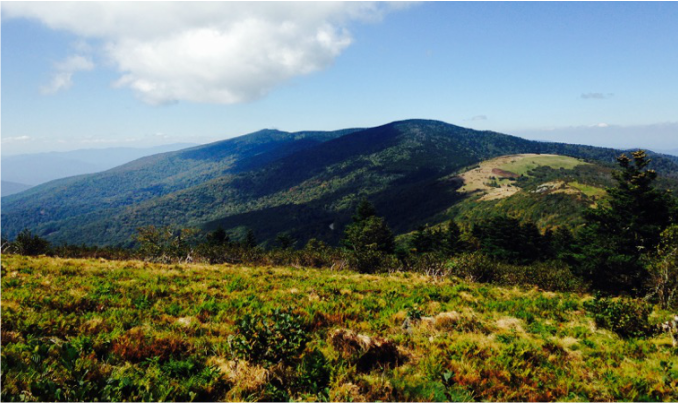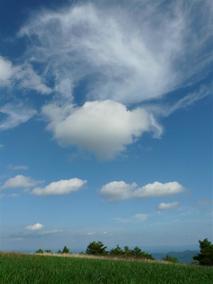 On invitation by the Wildlands Network, in September I participated in a discussion forum with four dozen conservationists that envisioned the establishment of a network of protected wild lands connecting Canada to the Florida Everglades and possibly westward along the Gulf Coast to Mexico. Now that is what I call a VISION! The group spent three full days in presentations, imagination, and discussion at the beautiful WildAcres Retreat Center in North Carolina’s Blue Ridge Mountains. While enjoying dramatic vistas of eastern North America’s highest mountain summit by day, and the glorious Milky Way galaxy above at night, three dozen invited conservationists and environmentalists joined with Wildlands Network founders, staff, board members, funders, and advisors to reflect on Wildland’s concept for creating an expansive, connected corridor of protected natural ecosystems and wildlife habitats extending across and around North America. Visionary thinkers and formulators of the Wildands Network and ReWilding America concepts – including Dave Foreman, Michael Soule, John Davis, and others – were present to offer their inspiration and perspectives. . . . (more)  {Note: The following essay was written by Gary Phillips, North Carolina writer, naturalist, entrepreneur. We read it with an eye toward this question: In this present Anthropocene Age,* what is Natural, what is Wild?} My favorite forest is the wood below our house. First of all, the rough driveway is lined with huge red cedars, remnants of a 100-year-old fencerow. The largest are over 50 feet tall. Along the edge of the house and pointing toward the creek is another fencerow, populated with dogwood and young water oaks and rich sassafras, all chaotically stretching toward any available light. In a band above our little creek there runs a field of 20- to 30-year-old loblolly pines, the memory of an abandoned pasture still in evidence along its margins: warm grassy patches bordered with berry vines, stone piles, barbed wired nailed to a post oak. The banks of the creek host maples and sweet gum and tag alder, with a few paw paws for grace. A black willow stands in its own patch of sunlight below the garden, bordered by wild persimmons and one feral pecan tree. It’s good to walk in the shade there, among the tanagers and jays. My favorite site is the small floodplain on the other side of the log bridge, grounded by a huge maple and a grove of ancient water oaks. The first time I walked there with my friend Leif Diamant we were met by a pair of pileated woodpeckers swimming from tree to tree. I thought: “I could live here.” This is no wilderness or pristine place. Everywhere there is evidence of human activity, even mismanagement. But this little forest is within my view from the kitchen table, always mysterious, surprising and changeable. It is precious to me. I try to love it as best I can. --Gary Phillips (Gary's website) *Anthropocene is a proposed term for the current geological age, viewed as the period during which human activity has been the dominant influence on climate and the environment.  As a member of the Board of a Louisiana land trust and someone who has been interested in the use of permanent conservation easements for a number of years, I offer an idea for expanding the use of conservation easements on lands whose owners are “land rich, but cash poor”—that is, the large majority of American landowners. My goal is to further the utilization of permanent conservation easements (CE) by all Americans. We know the current Federal Tax Code gives the majority of benefits/incentives (although there are some states with their own CE incentives) to those who conserve properties in perpetuity. With a little adjustment, current federal tax law could encourage Americans to preserve more rural lands through use of CEs. Such adjustments could prompt a positive boost to economic activity around our great country without causing the federal government to lose much, if any, tax revenue. The idea is to adjust the Tax Code (26 US Code 170 [h]) to allow the tax deduction incentives/benefits to be portable by creating a secondary market for the sale of CE tax deductions. This would encourage small landowners as well as the “land rich and cash poor” to participate in the conservation of lands that in most cases are taken permanently out of rural use because the only option available is to sell the land for development. . . . (more) |
When we see land as a community to which we belong, we may begin to use it with love and respect.... Conservation, viewed in its entirety, is the slow and laborious unfolding of a new relationship between people and land." There is in fact no distinction between the fate of the land and the fate of the people. When one is abused, the other suffers. From the PresidentSCP President Chuck Roe looked at land conservation along the route of John Muir's "Southern Trek." About ViewpointThis blog offers views of our Board and partners. We invite your viewpoint on the following questions: Archives
April 2024
Categories
All
|

 RSS Feed
RSS Feed